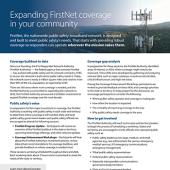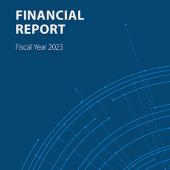This blog is a repost from the October 2020 edition of the IAEM Bulletin. The original article can be accessed here.
Emergency management thrives on good communication, and good communication is based on good information—pertinent, timely information. As a senior public safety advisor for the First Responder Network Authority (FirstNet Authority), I work with emergency managers and other officials to understand their current public safety communications, and what they need and want in the future.
One big thing I hear is that, with advances in broadband technologies, emergency managers now have access to more and better information than ever before. FirstNet, the nationwide public safety broadband network, is a key to accessing these new data sources at the right time and the right place.
When we envision the future for emergency management, we can look to today’s emerging technologies to understand where the field is trending.
Emergency management agencies are already modernizing operations with real-time data. Joe Sastre, who is IAEM’s representative on the FirstNet Authority’s Public Safety Advisory Committee, has provided expert guidance on shaping the future of public safety’s network. He said, “With the development and continued improvements we see in artificial intelligence, coupled with the capabilities of FirstNet, public safety officials will be able to routinely receive data and information as it occurs in real time, which will in turn enable us to make decisions about how we will protect our citizens, based on current information.”
These new technologies are being used in all four phases of emergency management: mitigation, preparedness, response, and recovery. Joe said, “For years we made our decisions based on what had recently been reported. Now we can make decisions based on better, fresher information and our dedicated public safety network will ensure that the information will get through to us.”
Drones are streaming live video in situations where human pilots can’t go. Human pilots are prohibited from flying at night over disaster areas because of the risks of crashing. Unmanned aerial systems don’t face those same restrictions. When the Kilauea volcano erupted in Hawaii in 2018, drones were able to monitor the lava flow overnight when it dangerously approached a geothermal power center. Although the center had been evacuated, it still housed toxic and explosive materials. The drones streamed live video via a FirstNet connection to the emergency operations center (EOC) 40 miles away. Officials were able to track the lava in real-time and better monitor a hazardous situation.
Emergency managers have unique insight into the network’s status. FirstNet has a feature called the Advanced Network Status Tool that allows authorized personnel—such as communications unit leaders, communications technicians, or Emergency Support Function #2 communications coordinators—the ability to view network details at the cell-site level. It even enables users to obtain more granular information on which specific sites within a network market area may be impacted by an outage.
Knowing where that critical infrastructure is—your communications lifeline—can be a key piece of data in real-time planning. This unprecedented visibility into your network is just one of the many differentiators that comes with being a FirstNet network subscriber, and a key ask from public safety for the network.
Recently, Travis Johnson with the Louisiana Office of Homeland Security and Emergency Preparedness used the tool to determine what communications assets to send with search and rescue teams responding to Hurricane Laura. “It enabled us to make better decisions about where to send our limited resources,” he said.
Mapping tools help create a common operating picture for responders in the field and the EOC. When the Rhode Island governor declared a state of emergency for a gas outage in 2019, the state emergency management agency organized a door-to-door operation to check on residents and inspect infrastructure. Using FirstNet-enabled smartphones, canvassers uploaded data to an app that tracked which residences were safe and where assistance was needed.
“Without having the use of FirstNet, it would have taken us hours to compile the data, relay it from one location to another, bring it in to the state emergency operations center, and then display it for the decision-makers,” explained Christopher McGrath, operations support branch chief at Rhode Island Emergency Management Agency. “Having that real-time access to data and the guarantee that we wouldn’t be interrupted by commercial network overloading in any particular area really made our response much more efficient.”
New technologies coming soon will enhance current capabilities. 5G is the next generation in wireless technology, and it will provide peak data speeds, higher throughput capability, and improved latency. For emergency management, that means a greater use of video—from fixed cameras or with drones, more accurate location data, and an ecosystem of connected vehicles, sensors, and devices that will change public safety communications. That’s why the FirstNet Authority Board has committed more than $200 million for initial network upgrades to set FirstNet on the path to 5G and to expand the fleet of deployables.
Drone video will evolve from the white-noise of a 24/7 data deluge to targeted footage that gives decision-makers crucial information to use at the right moment. Mapping technologies will encompass Z-axis location to give more precise geolocation data, especially for pinpointing the exact floor inside tall buildings. A proliferation of sensors will collect, process, and transmit data from multiple sources like smart buildings, weather sensors, and traffic sensors to provide better situational awareness.
The future of emergency management comes with new considerations. Emergency managers must be able to triage incoming information and make it useful in the moment. That’s why we’ve identified situational awareness as a key priority in the FirstNet Authority Roadmap, our guide for the evolution of the FirstNet network. We’ve heard from emergency managers and other officials that useful situational awareness technologies include mapping displays that clearly show the location of personnel and assets and standards-based devices that collect and synthesize vast amounts of data.
Another important consideration is to protect the influx of new data from cybersecurity threats. The information accessed and compiled by emergency managers must be secure from unauthorized use, adhere to security best practices, and comply with laws and regulations. Secure information exchange is another key priority that we’ve identified in the FirstNet Authority Roadmap. Unlike commercial networks, FirstNet is built with a dedicated, physical core that keeps public safety data separate from other users. The core offers advanced security measures, including end-to-end encryption, user authentication, and round-the-clock monitoring through a Security Operations Center staffed by a dedicated team.
A vision for the future of emergency management includes smart and secure communications. FirstNet is continuing to push the envelope for public safety communications, opening up new capabilities for emergency managers and the first responders they work with.
“FirstNet provides—for the first time ever in the history of this country—the ability to have one network for all public safety and all government resources to communicate in real-time,” said Brian Crawford, current FirstNet Authority Board member. “It’s a game-changer.”




















